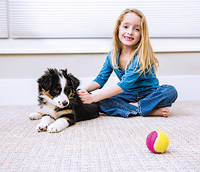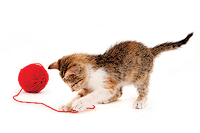|
It’s the coldest part of the year and getting out for a walk is not always possible. Indoor play is an essential part of keeping pets healthy, entertained, and emotionally balanced. While outdoor activities are important, there are many times when playing inside is more practical. Dogs and cats both benefit from indoor games that provide physical movement, mental stimulation, and social interaction. With simple toys and a bit of creativity, owners can turn everyday indoor spaces into exciting environments for their pets.
Dogs and cats need regular activity to prevent boredom and stress. Without enough stimulation, pets may develop unwanted behaviors such as excessive barking, scratching furniture, or chewing household items. Indoor games help release pent-up energy and encourage natural instincts in a controlled and safe environment. Just as importantly, playtime strengthens the bond between pets and their owners, building trust and positive communication.
Tug-of-War and Interactive Play for Dogs
One popular indoor game for dogs is tug-of-war. This activity allows dogs to use their strength while engaging directly with their owner. Using a durable rope or tug toy, owners can create a fun and energetic game that also teaches important skills such as self-control. Dogs should be taught to release the toy on command to keep the game safe and respectful. When played correctly, tug-of-war can be an excellent way to burn energy indoors and improve obedience.
Another form of interactive play involves using soft toys for gentle wrestling or controlled chasing. These activities give dogs a physical outlet while keeping them mentally engaged. Interactive games are especially beneficial for high-energy breeds that need regular stimulation even when they cannot go outside.
Puzzle Toys and Mental Challenges
Mental exercise is just as important as physical exercise for both dogs and cats. Puzzle toys and treat-dispensing games are excellent indoor options that encourage problem-solving and focus. Dogs may enjoy puzzle boards with sliding compartments or hidden treats, while cats often prefer smaller toys that release food when rolled or pushed. These toys help slow down fast eaters, reduce boredom, and keep pets entertained when owners are busy. Mental challenges are particularly useful for intelligent animals that need more than physical movement to stay satisfied.
Chasing Games for Cats
Cats are natural hunters, and indoor games that allow them to chase and pounce are especially rewarding. Wand toys with feathers, ribbons, or fabric strips are popular because they mimic the movement of prey. Owners can move the toy across the floor, around corners, or behind furniture to create excitement and unpredictability. Avoid using laser toys. Cats need to catch their prey to feel satisfied.
These games provide exercise and help indoor cats maintain healthy muscle tone. It is important to supervise play and store wand toys safely afterward to prevent chewing or tangling. Short but frequent play sessions work best for cats, as they often prefer bursts of activity followed by rest.
Creative Use of Boxes and Spaces
Cats are known for their love of boxes, and these simple household items can be turned into fun indoor playgrounds. Cardboard boxes provide hiding spots, climbing opportunities, and places to jump in and out of. Owners can cut small holes or stack boxes to create tunnels and levels, encouraging exploration and movement.
Dogs can also benefit from creative use of indoor spaces. Rearranging furniture slightly or using cushions and blankets can change the environment enough to keep playtime interesting. New layouts stimulate curiosity and help prevent boredom.
Indoor Obstacle Courses for Dogs
Obstacle courses are an excellent way to combine training and play for dogs. Using chairs, pillows, or broomsticks, owners can guide dogs to jump, crawl, or weave through obstacles. This activity improves coordination, balance, and confidence while reinforcing basic commands. Indoor obstacle courses are especially useful during cold or rainy weather when outdoor exercise is limited. They can be adjusted for different dog sizes, ages, and ability levels, making them a flexible and engaging option.
Modified Fetch Games Indoors
Fetch can easily be adapted for indoor play with the right equipment. Soft toys, foam balls, or rolled-up socks reduce the risk of damage to furniture or walls. Dogs often enjoy short-distance fetch in hallways, while cats may prefer batting lightweight toys across smooth floors. Rolling toys instead of throwing them helps keep the game controlled and safe. Even a few minutes of fetch-style play can help pets release energy and stay active.
The Importance of Safety and Balance
While indoor games are beneficial, safety should always come first. Toys should be appropriate for the pet’s size and chewing habits, and damaged toys should be replaced promptly. Owners should watch for signs of fatigue or frustration and end play sessions before pets become overstimulated. Balancing different types of play—physical, mental, and interactive—helps ensure pets remain healthy and happy. Short, regular play sessions are often more effective than long ones, especially for young or older animals.
Indoor games offer a valuable way to keep dogs and cats active, engaged, and emotionally fulfilled. From tug-of-war and obstacle courses for dogs to chasing games and box play for cats, there are many options that suit different personalities and energy levels. Indoor play not only supports physical and mental health but also strengthens the relationship between pets and their owners. With thoughtful planning and attention to safety, indoor games can provide lasting enjoyment and improve the overall quality of life for both dogs and cats.
|



